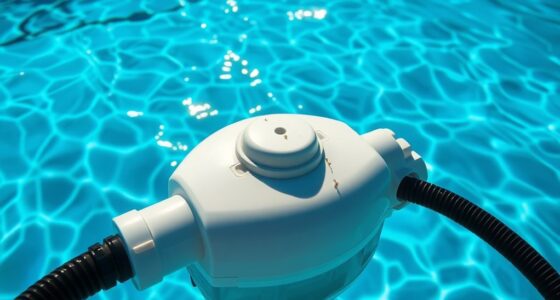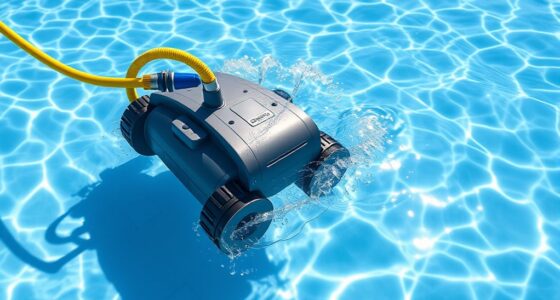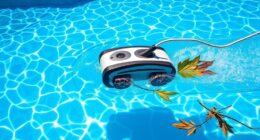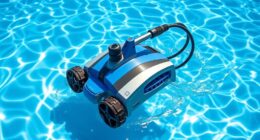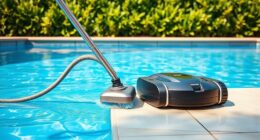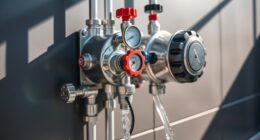To effectively maintain a pool without chlorine, it is recommended to test the water every 2 weeks using a professional kit. Keep an eye on the pH and sanitizer levels to prevent algae by addressing any chemical imbalances promptly. Use a chlorine remover to ensure safe swimming and carefully consider alternative sanitizers. Try using Saniteezy Pool Sanitiser for a skin-friendly and odorless experience. Choose copper-free algaecides to prevent staining and ensure a clear pool. Improve water clarity by using Filtrite Crystal Clear Clarifying Pill for a pristine swimming environment. Follow these steps for excellent pool maintenance and an invigorating swim.
Key Takeaways
- Test pool water regularly with a professional kit for accurate monitoring.
- Use a chlorine remover to neutralize chlorine and maintain a safe swimming environment.
- Incorporate Saniteezy Pool Sanitiser for a chlorine-free alternative.
- Prevent algae growth with a copper-free algaecide.
- Enhance water clarity with the Crystal Clear Clarifying Pill for a pristine swimming experience.
Testing the Pool Water Regularly
To maintain a chlorine-free pool effectively, you should test the pool water regularly every 2 weeks using a professional water testing kit. This important step allows you to monitor the chemical levels, including pH balance and sanitizer levels, ensuring a healthy swimming environment.
By conducting routine water testing, you can prevent algae growth and address any imbalances promptly. The process helps you identify any deviations from the ideal levels and take corrective actions to maintain a clean and safe pool.
Testing the pool water is essential to make sure that the chemical composition remains within the recommended parameters for a chlorine-free pool. By using a water testing kit designed for pools, you can accurately measure the pH balance and sanitizer levels, which are key factors in creating a comfortable and safe swimming environment.
Regular water testing is a proactive measure that aids in preserving the quality of the water and preventing issues that could arise due to imbalanced chemical levels.
Using a Chlorine Remover

Consistently testing the pool water guarantees a balanced chemical composition; now, consider using a chlorine remover to further maintain a chlorine-free pool.
When shifting to a chlorine-free pool, a chlorine remover plays an important role in neutralizing chlorine present in the pool water. This process is essential as it effectively removes residual chlorine, creating a safe swimming environment for you and your loved ones.
By using a chlorine remover, you can also explore the use of alternative pool sanitizers without the interference of chlorine. This step is necessary in maintaining a chlorine-free pool with minimal chemical presence, ensuring that your pool remains clean and safe for swimming.
Make sure to follow the instructions carefully when using a chlorine remover to achieve the best results and enjoy a crystal-clear pool while embracing a more environmentally friendly approach to pool maintenance.
Adding Saniteezy Pool Sanitiser
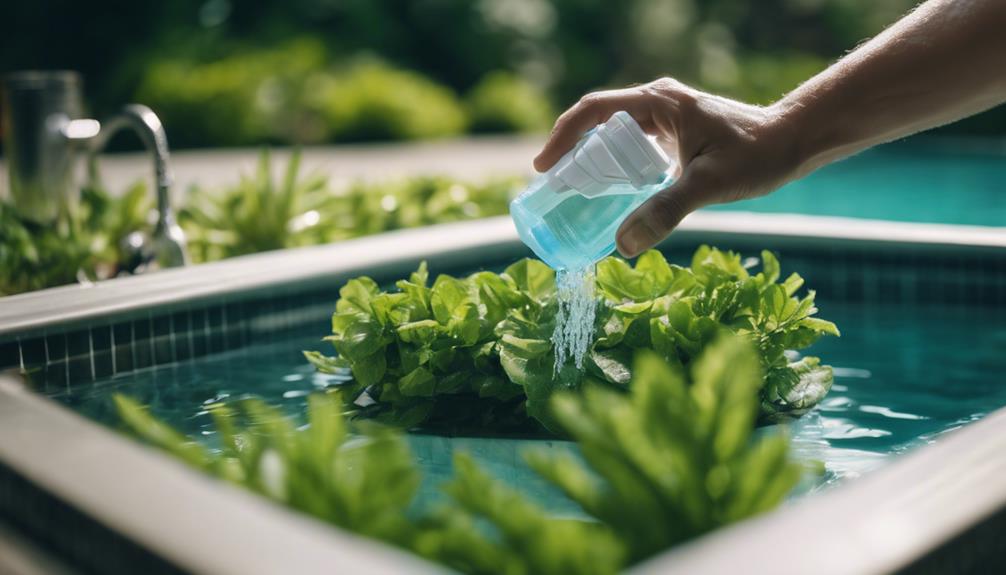
Consider incorporating Saniteezy Pool Sanitiser as a chlorine-free alternative for maintaining your pool. This innovative product eliminates the need for traditional chlorine sanitizing systems, making it an excellent choice for individuals with sensitive skin, allergies, or asthma.
By using Saniteezy Pool Sanitiser, you can enjoy a clean and enjoyable swimming experience without the typical chlorine odors that often accompany traditional chlorine treatments. This product not only helps uphold a pristine pool but also guarantees that your pool water remains safe and free from harmful bacteria.
With Saniteezy Pool Sanitiser, you can say goodbye to the hassle of dealing with chlorine and hello to a more convenient and eco-friendly way of keeping your pool in top condition. Make the switch to Saniteezy Pool Sanitiser today for a chlorine-free swimming experience that's both effective and enjoyable.
Incorporating a Copper-Free Algaecide

Explore the benefits of incorporating a copper-free algaecide to effectively maintain a chlorine-free pool. Copper-free algaecides are specifically designed to prevent algae growth without introducing copper ions into your pool water. By regularly applying a copper-free algaecide, you can avoid issues such as metal staining while guaranteeing that your pool water remains clear and clean. These algaecides are essential for peak effectiveness in chlorine-free pools, helping you steer clear of algae problems without the risk of copper buildup.
To visualize the advantages of using a copper-free algaecide, consider the following table:
| Benefits of Copper-Free Algaecide | Description |
|---|---|
| Prevents Algae Growth | Effectively stops algae from developing |
| Avoids Metal Staining | Eliminates the risk of metal stains |
| Keeps Pool Water Clear and Clean | Ensures the pool water remains pristine |
Utilizing a Crystal Clear Clarifying Pill

Enhance water clarity in your chlorine-free pool by incorporating the Filtrite Crystal Clear Clarifying Pill into your maintenance routine. This innovative solution is specifically designed to tackle suspended particles in your pool, effectively improving water quality without the need for chlorine or other harsh chemicals.
By utilizing the Crystal Clear Clarifying Pill regularly, you can prevent the buildup of cloudy water and enhance the overall aesthetics of your pool. Adding this clarifying pill to your maintenance routine is essential for maintaining crystal clear water in chlorine-free pools.
The pill works by efficiently removing impurities, leaving your pool water sparkling clean and inviting. Say goodbye to murky waters and hello to a pristine swimming environment by incorporating the Crystal Clear Clarifying Pill into your pool maintenance regimen.
Prioritize the clarity and quality of your pool water by utilizing this effective and chlorine-free solution.
Frequently Asked Questions
How to Maintain a Chlorine Free Pool?
To maintain a chlorine-free pool effectively, you must rely on alternative products and methods. Regularly test your pool water to monitor Saniteezy Pool Sanitiser levels and guarantee proper balance.
Use chlorine remover and Copper-free algaecide as needed, while adding Crystal Clear Clarifying Pill to keep the water clean.
Professional water testing every 2 weeks is essential for top-notch maintenance. Avoid using chlorine or bromine products, as they aren't suitable for a chlorine-free pool.
How Do I Keep My Pool Clean Without Chlorine?
To keep your pool clean without chlorine, consider alternative sanitizers like hydrogen peroxide, UV light, bromine, PHMB, or mineral sanitizers.
Test and maintain appropriate levels regularly, use chlorine-free pool algaecides and clarifiers, and follow a maintenance schedule with professional water testing every two weeks.
Seek advice and products from pool maintenance stores like Clark Rubber for effective maintenance of a chlorine-free pool.
What to Do if Your Pool Has No Free Chlorine?
If your pool shows no free chlorine, test for alternative sanitizers like hydrogen peroxide or copper ionization.
Consider using UV light systems or mineral sanitizers to keep your pool clean without chlorine.
Regularly monitor and adjust the levels of non-chlorine sanitizers, and use algaecides designed for chlorine-free pools to prevent algae growth.
Seek professional advice for best results in maintaining a chlorine-free pool and to guarantee proper sanitation levels for safe swimming.
How Do You Keep Chlorine Free Level?
To keep your chlorine-free pool levels stable, regularly monitor alternative sanitizer levels like hydrogen peroxide or UV light. Adjust the dosage as needed to combat harmful pathogens effectively. Follow manufacturer guidelines for best water quality maintenance.
Consider a balanced approach using hydrogen peroxide and UV light for efficient disinfection while keeping chlorine levels low. By staying vigilant and proactive, you can enjoy a safe and clean pool without relying on traditional chlorine treatments.
Can I Use Saltwater Pool Maintenance Techniques to Maintain a Chlorine-Free Pool?
Yes, you can use best practices for saltwater pool maintenance to maintain a chlorine-free pool. This includes routine cleaning, water testing, and adjusting the pH levels. Making sure the salt levels are correct and the filtration system is functioning properly are also crucial for keeping the water clean and safe.
Conclusion
To sum up, maintaining a chlorine-free pool requires a combination of proper testing, the use of chlorine removers, and alternative sanitizing products. By following these steps, you can enjoy a clean and safe swimming environment without the use of traditional chlorine.
For example, a family in California successfully switched to a chlorine-free pool system and noticed improved skin and eye irritation, demonstrating the benefits of this approach.
Remember, with the right products and maintenance routine, a chlorine-free pool is achievable and effective. In addition to using chlorine-free products, it’s important to regularly clean and maintain your pool to prevent the growth of bacteria and algae. Investing in a good filtration system and regularly skimming the surface of the water can help keep your pool clean and clear. Remember to also follow pool floating tips, such as regularly checking and balancing the pH and alkalinity levels, and keeping a close eye on the water’s clarity and color. By following these tips and staying on top of the maintenance, you can enjoy a refreshing and healthy chlorine-free pool all season long.




